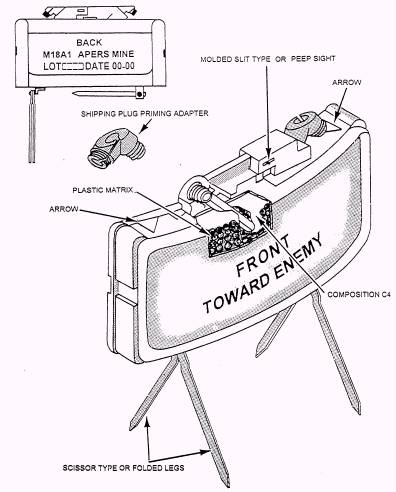|
LAND
MINES A
land mine is a concealed explosive charge, placed in an area where it can be detonated
by contact with enemy personnel or vehicles. Detonation can be initiated by
pressure, pull, or electrical action. The mechanism of a pressure mine is shown
in figure 12-12. The mine is buried with the fuze pressure plate just above the
ground surface and detonates when the plate is pressed down.

Figure 12-13.-The
M18A1 antipersonnel mine (Claymore).
A
pull-action mine is one that is detonated by the pull on a trip wire, stretched
where enemy personnel or vehicles may contact it. A pull-action mine is usually
a pressure mine. Whether it is used as a pull-action or pressure mine depends
on whether or not the ground surface makes the concealment of a trip wire
possible. For pressure installation, bury the mine with the top of the fuze
flush with the ground surface and only the prongs protruding above it. Install
the trip wire with the top cap of the fuze and the prongs protruding above the
surface. Run trip wires from the fuze cap to stakes or other anchorages, in
feasible directions.
An
electrical-action mine can be exploded by a remote-control firing device of the
type used for blasting in construction.
Except
for the M18A1 antipersonnel mine described below, mines are NOT authorized for
use by the Naval Construction Force (NCF). Personnel who encounter other types
of mines should not attempt to disarm or use them or handle them in any manner.
When located in the field, you should mark the mines clearly and furnish their
locations to the battalion security officer or authorized ordnance disposal personnel.
|

